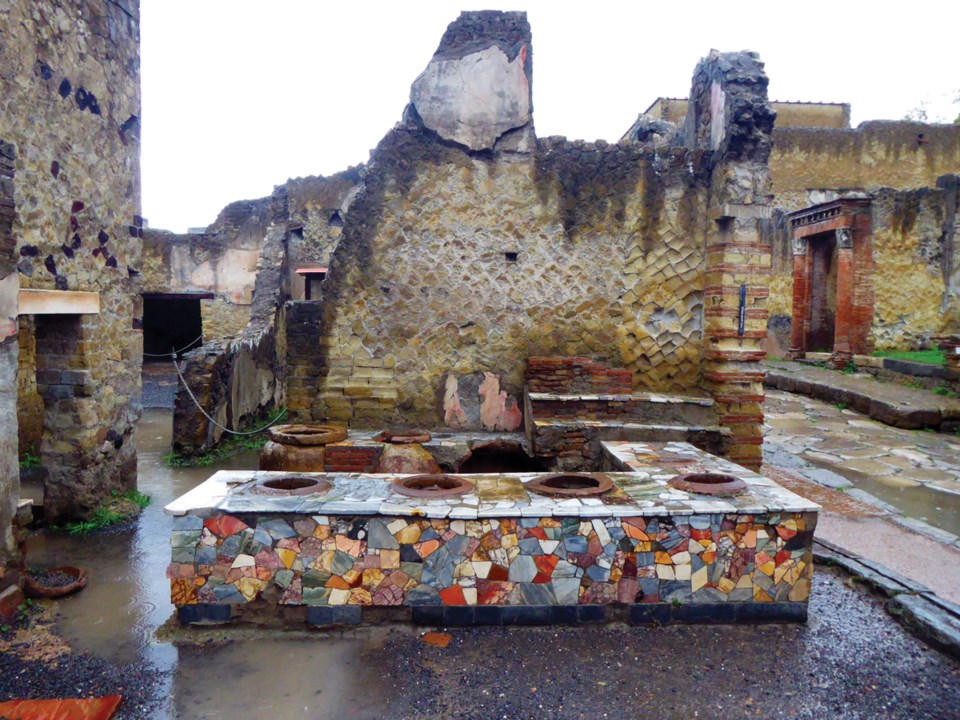From the elegant Viking Star, we explore astonishing early civilizations from Greece to Italy. At Naples, most shipmates visit Pompeii; we head to Herculaneum.
Looking down from the viewpoint, residences seem just recently deserted. The volcano that entombed the flourishing city for over 1,700 years rises ominously in the distance.
“Named for Hercules and smaller than neighbouring Pompeii, you’ll discover it equally splendid and better preserved,” guide Sofia explains.
“Though excavations have been ongoing since 1738, much of the ancient town remains buried. Located upwind from the volcano, Herculaneum sustained little damage from the falling ash and pumice that crushed Pompeii. Instead, flowing volcanic mud filled buildings from the bottom up, preventing their collapse. The mud formed an airtight seal that preserved the town.”
Descending a dimly lit tunnel, we cross a small bridge to the original dock. Bleached skeletons sit and sprawl under former boathouse archways. “Herculaneum prospered from trading and fishing. Archeologists believe most of the 20,000 residents escaped by sea,” recounts Sofia. “These stark remains likely represent those awaiting rescue.”
Gathering on an extensive terrace, Sophia tells us its namesake was Marcus Nonius Balbus, a prominent civic patron. His commanding marble figure stands high on a pedestal. Inscriptions on the adjacent memorial list his many accomplishments.
A ramped stairway leads upward into another public square. Sophia shepherds us along the main street, onto cobbled side streets and into compact, remarkably undamaged neighbourhoods. One public water fountain sports a man’s worn bearded mouth as a spout; another displays a carved relief of a gowned woman.
“Residents met daily at such fountains to get water and exchange gossip,” elaborates Sophia. “Some fountains flowed continuously, flushing the streets.”
Businesses intermingled with large villas and small. Conical basalt stones for grinding flour identify the bakery. Imagining aromas of fresh breads and honeyed cakes, we stroll to an early eatery. “This heated marble table kept foods hot in those pots,” Sofia points out. “Terra cotta jars held wines and olive oil. Nuts, figs, broad beans, chickpeas and olives filled smaller clay pots.”
Inside the public bathhouse, black and white tile floors depict a sea goddess, porpoises and octopus among ocean patterns. Traces of red, green and gold frescoes still adorn walls. “Without home facilities, citizens used public bathhouses,” smiles Sofia. “Women and men used separate rooms heated by hot water circulating through wall cavities; marble benches lined their lavish perimeters. Try visualizing everyone socializing here, playing knucklebone games and relaxing in the pools.”
Inside a series of villas, we notice distinctive characteristics prompting their names. The town’s first human remains were found in House of the Skeleton where a cupid relief sits above a shrine for household gods. Built in the second century BC, Samnite House features vivid red geometrics, the town’s oldest paintings. At House of the Wooden Partition, carbonized sliding doors separated the atrium from other rooms.
House of Neptune and Amphitrite proves especially memorable. A bedazzling glass tile mosaic decorates the dining room’s back wall. Geometric designs frame the exquisite figures of Neptune and Amphitrite. In an alcove opposite, shell and mother of pearl frame hunting scenes, marble theatrical masks perch above.
And a wealthy college in charge of glittering imperial events, Hall of the Augustales also stands out. Pedestals for Augustus and Julius Caesar’s grand statues remain. Wonderful mythically themed frescoes embellish opposite walls of the main alcove. On one side, Hercules sits beside Juno, Queen of Gods, and Minerva, Goddess of Wisdom. And on the other, he battles fiercely for Deianira’s love.
Travelling 2,000 years back in time at World Heritage Herculaneum inspires many new understandings of ancient Roman culture.
See www.vikingcruise.com for more information on cruises.



